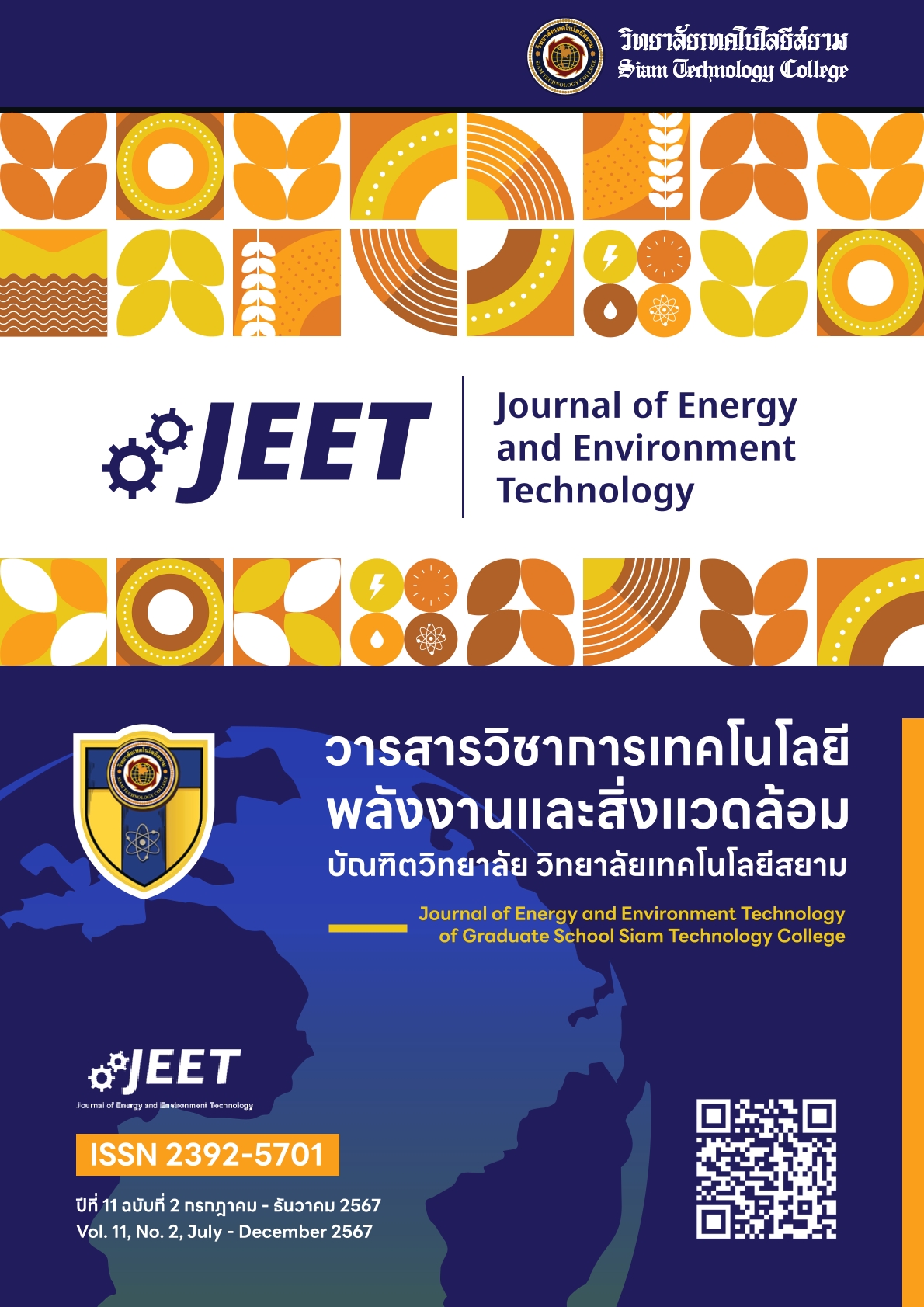EFFECTS OF OUTLET AIR VELOCITY AND COOLING WATER TEMPERATURE OF AIR COOLER WITH CLOSED-LOOP OSCILLATING HEAT PIPES
Main Article Content
Abstract
The air cooler original size 355 × 300 × 700 mm. The closed-loop Oscillating heat pipe (CLOHP) built from copper capillary pipes instead of cooling pad and contains R134a as working fluid. The effects of various parameters i.e., The Air flow rate, The water temperature and the number of heat pipes, The tests fan speed between 3.5 m/s to 4.2 m/s at cold water temperatures in the range of 6°C to 21°C. The CLOHP consists of 2 and 4 sets of heat pipes. The heat transfer rate decreased when increase air velocity for 2 and 4 sets of pipes. Increasing the cold-water temperature of both 2 and 4 heat pipe sets to have lower heat transfer rates and effectiveness decreased. Adding 4 heat pipes is better than using 2 heat pipes, and at the out-air humidity ratio, when using heat pipes, the value is reduced by 6.6% In air humidity ratio.
Article Details

This work is licensed under a Creative Commons Attribution-NonCommercial-NoDerivatives 4.0 International License.
เนื้อหาและข่อมูลในบทความที่ลงตีพิมพ์ในวารสารวิชาการ เทคโนโลยี พลังงาน และสิ่งแวดล้อม บัณฑิตวิทยาลัย วิทยาลัยเทคโนโลยีสยาม ถือเป็นข้อคิดเห็นและความรับผิดชอบของผู้เขียนบทความโดยตรง ซึ่งกองบรรณาธิการวารสารไม่จำเป็นต้องเห็นด้วย หรือว่าร่วมรับผิดชอบใด ๆ
บทความ ข้อมูล เนื้อหา รูปภาพ ฯลฯ ที่ได้รับการตีพิมพ์ในวารสารวิชาการ เทคโนโลยี พลังงาน และสิ่งแวดล้อม บัณฑิตวิทยาลัย วิทยาลัยเทคโนโลยีสยาม ถือเป็นลิขสิทธิ์ของวารสารวิชาการ เทคโนโลยี พลังงาน และสิ่งแวดล้อม บัณฑิตวิทยาลัย วิทยาลัยเทคโนโลยีสยาม หากบุคคล หรือหน่วยงานใดต้องการนำทั้งหมด หรือส่วนหนึ่งส่วนใดไปเผยแพร่ต่อ หรือเพื่อกระทำการใด ๆ จะต้องได้รับอนุญาต เป็นลายลักษณ์อักษรจากวารสารวิชาการ เทคโนโลยี พลังงาน และสิ่งแวดล้อม บัณฑิตวิทยาลัย วิทยาลัยเทคโนโลยีสยาม เท่านั้น
References
Wechillmart. (2020). How does the air conditioning system work, Retrieved September 16, 2019, from https://www.wechillmart.com/blog/air-conditioning-system-work/
Ingreen. (2018, April 4). Principle of Evaporative Cooling. Retrieved January 27, 2020, from https://ingreen.co.th
P. Charoensawan, et al. (2003). Closed loop pulsating heat pipes Part A: parametric experimental investigations. Appl. Therm. Eng, (23), 2009–2020.
P. Charoensawan and P. Terdtoon. (2008). Thermal performance of horizontal closed-loop oscillating heat pipes. Appl. Therm. Eng, (28), 460-466.
A. Siricharoenpanich, et al. (2019). Thermal management system of CPU cooling with a novel short heat pipe cooling system. Energy and building, (197), 100545.
H. Yang, et al. (2019). Experimental study on a pulsating heat pipe heat exchanger for energy saving in air-conditioning system in summer. Energy and building, (197), 1–6.
J.K. Calautit, et al. (2020). Numerical and experimental investigation of the indoor air quality and thermal comfort performance of a low energy cooling windcatcher with heat pipes and extended surfaces. Renewable energy, (145), 744-756.
Y. Tang, et al. (2021). Experimental investigation on active heat sink with heat pipe assistance for high-power automotive LED headlights. Case Studies in Thermal Engineering, (28), 1-10.
L.H. Saw, et al. (2021). Development of the closed loop pulsating heat pipe cool roof system for residential buildings. Case Studies in Thermal Engineering, (28), 1-11.
P. Charoensawan. (2012). Heat pipe technologies. Phitsanulok: Focus Printing.


